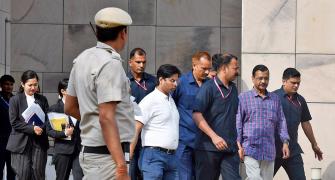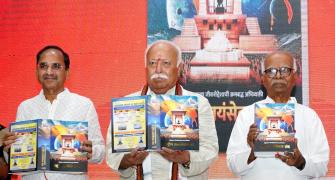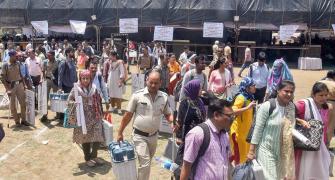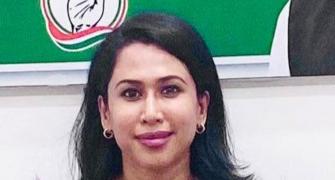Many American universities and think tanks are still fossilized within old paradigms like the Cold War, even though the US government now has a more nuanced understanding of India's potential as a democratic ally. The time has come for American universities and think tanks to re-image India. This means going beyond a post Cold War rethinking and into a post September 11, 2001 rethinking.
India in the American mind
Asia is reclaiming its historical position as a leader of innovation, wealth creation and global culture. Across America's school systems, there is a groundswell of interest in Asian studies, and it is refreshing to note that this trend is driven by the intention to remove many prevailing stereotypes.
For instance, the Committee for Proposing Asian Studies in New Jersey recently examined a report by the Asia Society, which recommends the following reasons for teaching Asia in American schools:
'...as a nation, deeper understanding of Asia will be critical to sustaining our economic well-being, improving our living standard, opening new markets, maintaining peace, and embracing cultural diversity.'
The report goes on to propose that the curriculum should depict Asia as a market, as a partner, as a competitor, and as a growing part of American culture.
One must highlight what this report is not recommending: It does not recommend that the core theme should be to prosecute Asia on human rights in the classroom, or to focus primarily on other divisive issues, or to glorify the west's triumphs in Asia over the past few centuries. On the contrary, the report emphasizes moving the discourse away from Eurocentrism to better explain Asian civilizations as serious markets, partners and competitors, and as suppliers of American culture.
Furthermore, the Committee has agreed that 'respect for Asia and Asians' should be a central theme in the future curriculum. For example, while history books should include critical thinking, they should not disparage whole cultures and civilizations from Eurocentric perspectives.
A review of current educational materials shows that presently India is not taught according to these proposed new guidelines. Moreover, the teaching of India is not on par with practices that characterize the teaching of many other Asian countries. For instance, while China, Japan and Korea are usually studied as distinct countries, India, a rising economic power, the world's largest democracy, and the second most populous nation on earth, is not given comparable treatment. Instead, India is subsumed in the amorphous and incoherent grouping of South Asian 'problems.'
The South Asia construct is sometimes defended on the grounds of fostering peace and harmony. However, superimposing a false view of similarities is not the way to harmony. The distinctions between China and Japan do not come in the way of their friendly relationships. Men and women are friends, but are not the same. Individuals of diverse races, ethnicities, cultures and religions should be friends, and yet their distinctiveness should be celebrated. India's jatis co-existed peacefully for millennia without any movement to erase their distinctiveness. On top of the naiveté that harmony requires similarity, there is a second layer of flawed thinking: that the burden is on Indians to be like the others, in the interest of political correctness and harmony. One could even theorize that Pakistan's recent interest in (apparent) friendship with India is because of India's enormous success.
India's complex relationship with its neighbors is no reason to paint it with the same brush, particularly when India has clearly outstripped its neighbors in every respect. Furthermore, India is many times more complex than Japan or Korea, by virtue of its multi-ethnic, multi-lingual, multi-religious and multi-political nature. Almost every state in India is larger in area and population, than most nations in the world.
Why, then, is Kissinger's strategy of 'balancing' India with Pakistan still the implicit meta-narrative in US universities and think tanks today? Why do these scholars under-value the fact that India is ten times Pakistan's size in economic terms and that the differences are even greater in the rates of technological and sociological development?
Current educational materials tend to portray India in terms of hopeless poverty, backwardness and superstition -- using caste and conflict as the predominant lenses. On the other hand, countries like China, Japan, Korea and Singapore are approached from their own positions of strength.
Fortunately, each of my Asian-American colleagues on the Committee is very supportive about repositioning India's treatment as a major positive player in the global economy, technology and culture.
The discrepancy between what many American school educators want to teach about India, and what the curriculum offers, may be originating in American higher education, aided and abetted by certain Indian-American scholars.
There is a contradiction between the US government's positive new policies towards India and the jaded focus of many Indian-American scholars. This is a matter of grave concern, as many such scholars are also political activists, and they can exacerbate the cleavages in Indian society in ways that subvert and destabilize its sovereignty.
To be critical is scholarly, but being hostile is prejudice. Many of these scholars maintain ambiguous identities to conceal their ideological hostility to the majority religion and culture of India. This column hopes to unmask this ambiguity.
America's Paradigm Shift
US strategic interests, including the collective interests of its citizens, businesses and government, should determine its aims in teaching India. The old paradigm was the Cold War. India was classified either as a Soviet satellite to be contained, or, at best, as an exotically strange civilization or a patient of cultural diseases.
In the new paradigm, however, the Soviets are gone, and the US faces three new threats: Pan-Islam, China, and labor competition from overseas.
The Islamic threat is often seen as a disorganized and scattered force that would take the world back to pre-modernity. Later, how this threat could play out in South Asia is explained.
China is seen as a highly modernistic threat, using economic and technological might to try to beat the west at its own game of power projection.
The third and most recent threat (which could also be leveraged as an opportunity) has yet to be seriously examined, but has already become a hot political issue: the impact of the emerging global free market of labor. Recent high profiling of the outsourcing phenomenon has made many Indians very proud, for good reasons. But when Japan got similarly profiled in the 1970s, it led to a massive US political and labor backlash. That is when the Japan Foundation, with the help of Asia Society and others, swung into action, to re-educate Americans in a positive manner at all levels about Japan. Result: Japan-bashing stopped. Unfortunately, there is no similar strategy with respect to India, or even an adequate understanding of this issue.
In addition to this new geopolitical reality, there are other major changes (with respect to India) that are being woven into the US socio-political tapestry: the rise of the Indian Diaspora voice and the inculturation of America with Indian spirituality, music, cuisine, fashions and culture in general. These positive new images of India often conflict with the negative and morbid images still advocated by many scholars in South Asian studies.
Old India was seen as incapable of making positive contributions to the US or the world at large, and was studied for its otherness to the normal, i e in contrast with Western civilization. Old India's desi elitists still try to outdo each other in proving their rejection of native Indian symbols and identity by adoption Western substitutes. They resemble starving hands reaching out to the West for nourishment. India-bashing has become their passport to 'Civilization,' which they consider to be synonymous with adoption of a Western identity.
Indian scholars' US nexus
Many Western-based South Asian Studies scholars are either members of or affiliated with specific Indian political parties and/or political NGOs (Non-Government Organizations). These range from Dalit separatists, Muslim extremist groups, Communist parties (especially Communist Party of India (Marxist)), Christian proselytizers, Congress Party Nehruvianists, etc, to name a few. The field is highly skewed to the kind of radical Left whose political positions destabilize India, and is not balanced by criticism of those positions from opposing perspectives.
The 'Left' as it manifests in the Indian environment is very different from what liberal middleclass Americans view as Left. In the US, the Left is where the heart is, and this is very different from an Indian leftist's orientation, which is colder and more opportunistic. To give a specific example, the typical leftist/liberal profile in America often thrives on traditional Indian culture, such as yoga, meditation and vegetarianism, whereas the Indian 'Left' considers these as the chief culprits coming in the way of 'progress.'
These Indian scholars use their Western academic credibility to raise funds from the Diaspora, and use the money to sponsor unrest in India and foreign travel for their comrades back home. The Indian side of this axis provides filtered data to US-based activist-scholars, as well as a channel in India to distribute the ideology spun on US campuses.
A series of case studies needs to be done to ascertain whether these linkages compromise academic objectivity. In particular, shouldn't such affiliations have to be disclosed to students, to peers and to the public, so that they may factor these potential conflicts-of-interests while interpreting the scholarship and making donations? To what extent are certain US-based academic scholars operating as satellites of specific political parties and movements in India?
To appreciate what is going on, the following hypothetical analogy may help: Imagine if Michael Moore or Bill O'Reilly was hired as a professor in a Chinese college as the authority on American politics, and there was no alternative perspectives presented. Imagine if people like Reverend Al Sharpton, Pat Robertson, and other fringe political activists in the USA, were to capture the chairs of America studies in prestigious Chinese universities, and were seen as the 'voices of America.' Would that give the students and public in China a broad, balanced and fair portrayal of America?
The analogy becomes even more poignant if one further imagines that these American scholars in China were adopting the Chinese identity, because, hypothetically, it had a far superior brand premium than their original American identity. As a consequence, these American scholars would be alienated from America and enthusiastic about denigrating it in China as a way to prove their Chinese-ness and to advance their Chinese careers.
Finally, to complete the analogy, imagine that these self-alienated Americans in China were aiding and abetting insurgencies in America on 'human rights' grounds. (Of course, in practice, such a hypothetical scenario could only be possible if China was the world's foremost power and America was a poor third world country.)
This analogy has serious implications especially for the many desi pseudo-leftist and 'sub-nationalist' scholars and authors in the US, whose personal narratives are not shared by the vast majority of the billion people of India. To become members of the Western Grand Narrative -- even in marginal roles -- these Indians often sneer at Indian culture in the same manner as colonialists once did.
Recalling my days at St Stephens College (Delhi), such Indians tended to have excellent communications skills in English. In fact, English Honors was the discipline that produced the largest number of these 'intellectuals,' followed by History Honors. They mastered the art of quoting from Western literature, philosophy, politics and history in order to create an impression, but had very little depth of understanding. In particular, their knowledge of their own heritage was limited to simplistic conclusions which they had picked up from Western accounts.
Western academe employs these brown sahibs as 'Indian voices.' But many of them are career opportunists, and are artificially sustained by Western funding and patronage, enjoying little legitimacy back in India. They are also out of place in this era of free markets, having received sanctuary in US South Asian studies. To sustain their credibility and usefulness in the US, they must constantly dish out sensational accounts of problems in India. They are simply Uncle Toms.
While espousing anti-colonialism, they are, in reality, the neocolonized, and their intellectual positions are often diametrically opposed to what liberal American secularists would advocate. Some examples illustrate why they are 'pseudo' leftists:
1. India's pseudo-leftists oppose bringing a uniform civil code for marriages in India, because this enables them to exploit Hindu/Muslim cleavages, even though this has denied human rights to Muslim women. No American liberal has proposed that there be a separate Muslim Civil Law or a separate Jewish Civil Law or a Black Civil Law in America.
2. They oppose proposals to bring secular education to India's tens of thousands of madrassas (Muslim religious schools), even though these proposals would add science, math and democracy to the curriculum, and prepare Indian Muslim students to prosper in the new global workplace. This appeasement of the orthodox Muslim clergy is driven by their own petty agendas.
3. While yoga/meditation are accepted by American liberals, Indian pseudo-leftists vociferously oppose every attempt to introduce yoga in India's schools (on the grounds that it is primitive superstition), and thereby deny Indian society the benefits of stress reduction, violence reduction and increased compassion that are now well recognized by several studies in the US.
4. While interfaith dialogs are becoming commonplace in America, and China's government funds academic religious studies and the restoration of 500 Buddhist shrines, India's pseudo-leftists continue to deny that religiosity is a legitimate part of being human. Furthermore, they do not believe in building common ground, and continue their call for all-out war to defeat Indian dharmic traditions, for the sake of some sort of apocalyptic birth of Utopia on Earth. They are, in fact, contributing to the radicalization of Hinduism in India.
The US must protect its interests by reducing its dependence on those Indian scholars who are trapped in obsolete paradigms. It must articulate its own long-range strategic vision, and New India's place in it, and then reevaluate each of the programs in South Asian studies through such a lens. Presently, many of the tilts in academic programs are unofficial or covert remnants of the past that have simply not been re-examined since the ground shifted. They are often subliminally carried out, without many scholars being fully aware of the larger picture.
The reason that so many recent events in India contradicted what these Indian scholars predicted is not that India is incoherent; but, rather, that many pundits installed in US academe are simply unreliable.
Lessons not learnt
US policy has made many catastrophic miscalculations in Asia in the past, because its intellectuals had a murky and befuddled understanding of non-western cultures and politics. Similar errors of judgment cannot be ruled out in the case of India. Deposing the Shah of Iran on the grounds of human rights violations did not improve human rights in Iran under the Ayatollahs that followed. Repeatedly backing Pakistani military coups has subverted its fragile democratic institutions, and has reduced it into a nation governable only by the military or by the mullahs. Pampering the Saudi theocrats for decades has alienated the Arab populace. One wonders about the role of academic scholars in these short-sighted policies, and the extent to which they may have simply ignored data that was incompatible with their own personal ideologies and agendas.
Following the Soviet withdrawal from Afghanistan, the US-backed Mujahideen reinvented themselves as anti-US jihadis. US Secretary of State Zbigniew Brzezinski had proudly sponsored and cheered the Islamic jihadis against the Soviets. Dan Rather, the CBS News anchorman, profiled the Mujahideen as the brave heroes of freedom. But this dangerous strategy of 'my enemy's enemy is my friend' blew up in unexpected ways and in far-away places. The US failed to mop-up the loose weapons that it had given to the Mujahideen, despite the fact that the weapons bazaars of Peshawar were prominently featured in the US media. The US simply failed to dismantle the jihadi organizational apparatus that it had helped set up.
Meanwhile, South Asian Studies seminars, conferences, talks and documentaries were stampeding for staple topics such as caste, sati, dowry, a rat temple in India, snake worshiping and naked sadhus; but the real threats facing Americans from Pakistan-Afghanistan (part of the US government's definition of South Asia) were simply ignored.
US policymakers who were involved simply moved on in their personal careers, creating a discontinuity of perspective and a lack of accountability. Scholars of South Asia did not bat an eyelid, either, and went on with business as usual. There has been an inadequate post-mortem analysis of their flawed thinking. The collective amnesia allowed similar mistakes to be repeated.
The extent to which these scholars fit their findings to suit the needs of political activists and lobbying groups remains a mystery. The system has yet to sponsor any independent research on the history of South Asian scholarship over the past two decades and its contribution to American policy. There is research published on how the Soviet Union, China and Japan were mismanaged by their respective governments. But the management of scholarship on South Asia has not been placed under the microscope.
Ill-conceived policies towards India pose a serious future threat to American strategic interests.







